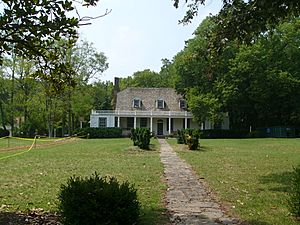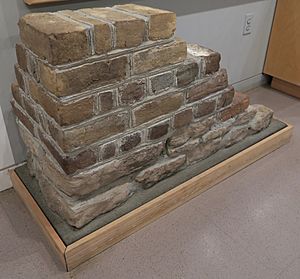Leesylvania (plantation) facts for kids
|
Leesylvania
|
|
| Nearest city | Dumfries, Virginia |
|---|---|
| Built | c. 1750 |
| NRHP reference No. | 84003565 |
Quick facts for kids Significant dates |
|
| Added to NRHP | September 13, 1984 |
Leesylvania was a large farm and historic home in Prince William County, Virginia. It belonged to Henry Lee II and his wife Lucy Grymes. Many enslaved people were forced to work there.
The farm was known for its good land and especially for growing tobacco. The Lee family raised five boys and three girls at Leesylvania. Some of their most famous children were Henry "Light-Horse Harry" Lee, Richard Bland Lee, and Charles Lee.
Today, only a small part of the house's foundation can be seen. It is now part of Leesylvania State Park. The house and its path were removed in the 1950s to build a road. Henry Lee II and his wife are buried on the property. However, their headstones were moved to Union Cemetery in Leesburg in 1969. You can visit the site and the cemetery by following a trail. The Leesylvania Archeological Site was added to the National Register of Historic Places in 1984.
Leesylvania's History

The land for Leesylvania was first given out in four parts. These were called "headright grants." Each grant was 50 acres for every person brought into the Virginia colony. In 1658, Henry Corbin got this land. He gave it to his daughter, Laetitia. It would become hers when she grew up or got married. In 1679, this spot was chosen for an English fort to protect against Native Americans. The oldest grave found here dates back to 1690.
When Richard "the Scholar" Lee II married Laetitia Corbin in 1675, he gained ownership of the land. This land was along the Potomac River and known as Freestone Point. It was passed down through his son, Henry Lee I, to his grandson, Henry Lee II. Henry Lee II inherited 2,000 acres in 1747. This land would later become Leesylvania, meaning "Lee's Woods." Around 1750, he chose a high ridge overlooking the Potomac River for his home. It is thought to have looked like Rippon Lodge, a nearby house built around the same time.
Life at Leesylvania
Like most large farms of that time, Leesylvania depended on enslaved labor. When Henry Lee II died in 1787, he owned 55 enslaved people. They were forced to work on the property. The main crops grown at Leesylvania were tobacco, corn, and wheat. They also produced dairy products. There was even a business for commercial fishing. In 1767, an enslaved man named Harry from Leesylvania, along with an enslaved iron worker named Gawin from a nearby iron factory, tried to harm Lucy Grymes.
When Henry Lee II died in 1787, Leesylvania was left to his wife, Lucy. After her death in 1792, it went to their second son, Charles. Henry Lee II purposely did not leave most of his other properties or belongings, including enslaved people, to his oldest son, "Light-Horse Harry". This was likely because "Light-Horse Harry" often made bad money decisions. The house had burned down in 1790. Charles briefly mortgaged 2,040 acres to William Lee. In 1825, Lee II's grandson, Alfred, sold the land to Captain Henry Fairfax. You can still see the chimney of the Fairfax home in Leesylvania State Park.
What was left of the main house was destroyed in the 1950s. This happened when a road was built for the Freestone Point Resort. A small part of the original foundation can still be seen in Leesylvania State Park. A corner of the house has been rebuilt in the Visitors Center. It uses sandstone from the property and bricks saved from the original site.
Visiting Leesylvania Today
The remains of Leesylvania are now inside Leesylvania State Park. You can reach them by walking along the Lee's Woods Trail.
Images for kids









